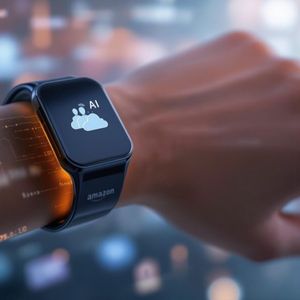AI Wearables: Amazon’s Bold Move Revolutionizes Smart Devices Amidst Privacy Concerns
8 min read
BitcoinWorld AI Wearables: Amazon’s Bold Move Revolutionizes Smart Devices Amidst Privacy Concerns In the fast-evolving landscape where technology constantly reshapes our daily lives, the recent Amazon acquisition of AI wearables startup Bee has sent ripples across the tech world. For those keenly following the intersection of innovation and personal data, this development marks a pivotal moment, hinting at a future where our smart devices are more integrated and, potentially, more intrusive than ever before. This move by a tech giant like Amazon into the burgeoning AI wearables market could redefine how we interact with ambient intelligence, but it also raises critical questions about data privacy and the ethical deployment of advanced AI technology . Let’s dive deep into what this acquisition means for consumers, the future of personal tech, and the delicate balance between convenience and privacy. What is Bee, and Why Did Amazon Make This Amazon Acquisition ? Bee, a relatively new player in the AI space, caught the attention of Amazon with its unique approach to ambient intelligence. Founded by Maria de Loudres Zollo, Bee developed a wearable device—available as a standalone bracelet or an Apple Watch app—designed to act as a “trusted companion” that records everything it hears. The primary goal? To seamlessly listen to your conversations and, without direct prompting, create helpful reminders and to-do lists, essentially mirroring your phone’s functionality in a more ambient, hands-free manner. Last year, Bee successfully raised $7 million, signaling investor confidence in its vision. The device itself is notably accessible, retailing for just $49.99, complemented by a $19-per-month subscription fee for its ongoing services. This low entry barrier distinguishes Bee from other high-priced AI hardware attempts, making it an attractive proposition for curious consumers unwilling to make a significant financial commitment. For instance, the ill-fated Humane AI Pin, a similar concept, launched with a hefty $499 price tag. Amazon’s decision to pursue this Amazon acquisition is a clear strategic play. While Amazon has long dominated the voice-controlled home assistant market with its Echo line of speakers, the Bee acquisition signals a pivot towards wearable AI devices. This represents a distinct and increasingly important frontier in personal technology. It indicates Amazon’s ambition to extend its AI ecosystem beyond the home and into users’ everyday lives, offering a more pervasive and personalized AI experience. An Amazon spokesperson confirmed that Bee employees have received offers to join the tech giant, indicating a commitment to integrating Bee’s talent and technology into Amazon’s broader innovation efforts. This move positions Amazon directly alongside other tech behemoths like OpenAI, Meta, and Apple, all of whom are actively exploring or rumored to be developing their own AI-powered hardware, from smart glasses to dedicated AI devices. Exploring the Capabilities of AI Wearables : More Than Just a Bracelet? The concept behind Bee’s AI wearables is both fascinating and a little unsettling. Imagine a device constantly listening, processing your spoken words, and then intelligently generating actionable insights. Bee’s vision extends beyond simple dictation; it aims to create a “cloud phone”—a mirror of your existing smartphone that grants the personal Bee device access to your accounts and notifications. This seamless integration would enable it to provide real-time reminders about events, facilitate message sending, and generally streamline your digital life without you ever needing to pull out your phone. The company’s website eloquently states, “We believe everyone should have access to a personal, ambient intelligence that feels less like a tool and more like a trusted companion. One that helps you reflect, remember, and move through the world more freely.” This aspiration for a truly ambient and proactive assistant highlights the transformative potential of AI wearables . Unlike traditional voice assistants that require a wake word, Bee’s always-on listening capability aims to capture context naturally, leading to more relevant and timely assistance. However, this always-on nature is precisely where the core challenge lies. While the convenience is undeniable, the implications for personal privacy are profound. The goal is to move beyond reactive commands to predictive assistance, making our interactions with technology feel more intuitive and less like a chore. As other companies like Rabbit and Humane AI have discovered, achieving this balance while building consumer trust is incredibly difficult, and widespread adoption has remained elusive thus far. Bee’s lower price point, however, might just be the key to unlocking broader consumer experimentation in this emerging category of smart devices . The Crucial Conversation: Navigating Data Privacy in a Connected World Perhaps the most significant discussion surrounding AI wearables like Bee revolves around data privacy . A device that “records everything it hears” immediately raises red flags for many. How is this vast amount of personal audio processed, stored, and used? Different companies approach these critical questions with varying policies, and understanding these differences is paramount for consumers. Before the Amazon acquisition, Bee had outlined several privacy-centric policies: User Control: Users could delete their data at any time. Audio Handling: Audio recordings were explicitly stated not to be saved, stored, or used for AI training. This is a crucial distinction, as many AI models are trained on vast datasets, including user interactions. Learned Data: While audio wasn’t stored, the AI did store data it learned about the user to function as an assistant. This includes preferences, recurring events, and inferred needs. Consent-Based Recording: Bee previously indicated plans to only record the voices of individuals who had verbally consented, a significant step towards ethical data collection. Boundary Definition: The company was working on a feature allowing users to define boundaries based on topic or location, which would automatically pause the device’s learning. On-Device Processing: Bee also noted its intention to build on-device AI processing, which generally offers a higher degree of privacy compared to cloud-based processing, as sensitive data never leaves the device. However, the integration of Bee into Amazon introduces a layer of uncertainty regarding these policies. Amazon’s track record on data privacy , particularly concerning its Ring security cameras, has been mixed, to say the least. In the past, Amazon shared footage from personal Ring cameras with law enforcement without the owner’s consent or a warrant. Furthermore, Ring settled claims in 2023 brought by the Federal Trade Commission (FTC) alleging that employees and contractors had broad and unrestricted access to customers’ videos. This history casts a long shadow over how Bee’s privacy policies might evolve under Amazon’s ownership. The balance between Amazon’s drive for innovation and its responsibility to protect user data will be under intense scrutiny, especially given the intimate nature of a device that records conversations. Beyond the Wrist: How Smart Devices Are Evolving The market for smart devices , particularly those incorporating advanced AI, is undergoing rapid transformation. While Bee’s affordable price point and subscription model offer a unique entry into the market, it’s far from the only player. As mentioned, companies like Rabbit and Humane AI have attempted to carve out niches with their own AI-enabled wearables, albeit with limited success so far. The challenges include not only technical hurdles but also convincing consumers of the necessity and trustworthiness of such always-on companions. Meanwhile, established tech giants are integrating AI technology into their existing hardware ecosystems or developing entirely new categories: OpenAI: The maker of ChatGPT is reportedly working on its own AI hardware, indicating a belief that the future of AI extends beyond software interfaces. Meta: Has been actively integrating its AI capabilities into its smart glasses, pushing the boundaries of augmented reality and ambient computing. Apple: Rumored to be developing AI-powered smart glasses, leveraging its vast ecosystem and focus on user experience. This landscape suggests a broader industry trend towards more intelligent, proactive, and seamlessly integrated smart devices . The competition isn’t just about features; it’s about building trust, addressing privacy concerns, and demonstrating genuine utility that justifies the always-on nature of these new gadgets. The success of these devices hinges on their ability to truly enhance daily life without becoming an intrusive presence, a delicate balance that tech companies are still striving to perfect. The Future Trajectory of AI Technology in Personal Gadgets The acquisition of Bee by Amazon is more than just a corporate transaction; it’s a strong signal about the future direction of AI technology in personal gadgets. We are moving towards a world where AI is not just a tool we interact with on screens, but an ambient presence that anticipates our needs and assists us proactively. This shift from reactive to proactive AI, enabled by wearable form factors, promises unprecedented levels of convenience and personalization. However, this future comes with significant ethical and practical considerations. The sheer volume of personal data collected by such devices—from our conversations to our daily routines—presents both immense opportunities for personalized assistance and profound risks if mishandled. The policies governing how voice recordings are processed, stored, and used for AI training will become critical differentiators for companies in this space. Transparency, user control, and robust security measures will not just be desirable features but essential requirements for building consumer trust. For consumers, the rise of advanced AI wearables means a greater need for vigilance. It’s imperative to scrutinize the privacy policies of these devices, understand how your data is handled, and make informed choices about the level of ambient intelligence you’re comfortable inviting into your life. The promise of a “trusted companion” is alluring, but ensuring that trust is genuinely earned and maintained will be the defining challenge for companies venturing into this exciting yet complex domain of AI technology . The Amazon acquisition of Bee marks a pivotal moment in the evolution of AI wearables , pushing the boundaries of what our smart devices can do. While the prospect of a truly ambient and intelligent assistant is exciting, the paramount importance of data privacy cannot be overstated. As AI technology continues to advance, fostering consumer trust through transparent practices and robust security will be crucial for widespread adoption. This development underscores a broader industry shift towards more integrated and proactive AI, inviting us to carefully consider the balance between unparalleled convenience and the safeguarding of our most personal information. The coming years will reveal whether this bold move by Amazon truly revolutionizes the market or simply adds another layer to the ongoing conversation about technology, privacy, and the future of human-computer interaction. To learn more about the latest AI technology trends, explore our article on key developments shaping AI features. This post AI Wearables: Amazon’s Bold Move Revolutionizes Smart Devices Amidst Privacy Concerns first appeared on BitcoinWorld and is written by Editorial Team

Source: Bitcoin World



